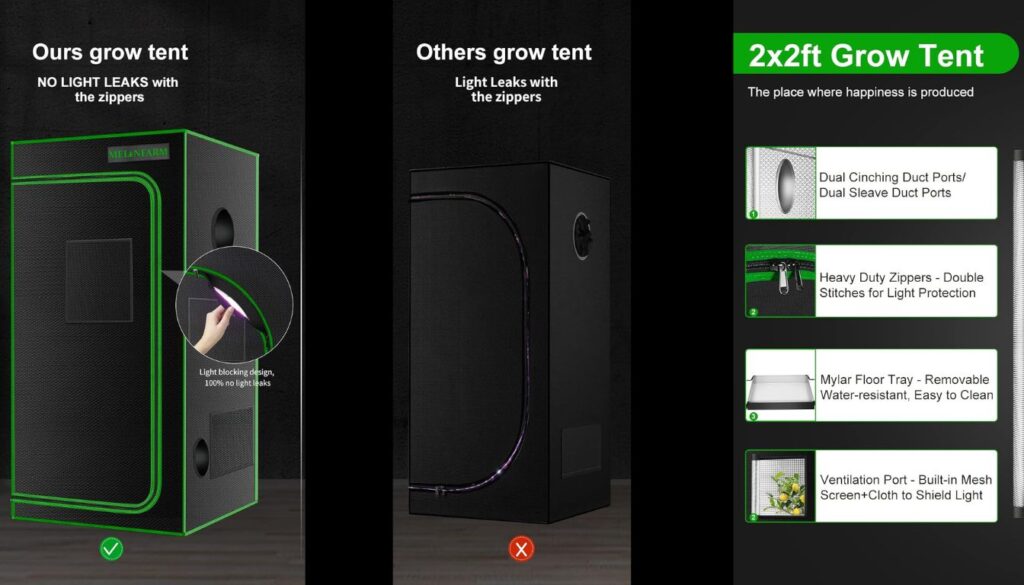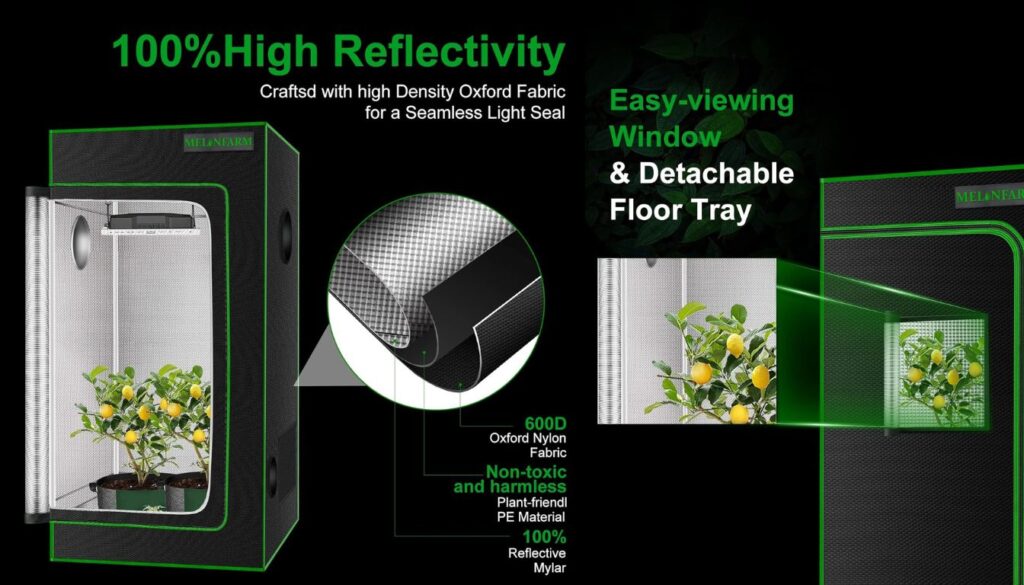Setting up a grow tent can transform your indoor gardening game. Imagine having complete control over your plant’s environment, from light to humidity, all in a compact space. Whether you’re a seasoned pro or just starting out, a grow tent offers the perfect solution for cultivating healthy, thriving plants year-round.
Understanding Grow Tent Set-Up
Setting up a grow tent is essential for effective indoor gardening. It creates a controlled environment that promotes healthy plant growth.
What Is a Grow Tent?
A grow tent is an enclosed space designed for indoor gardening. It typically features reflective walls that maximize light exposure while sealing off the external environment. These setups accommodate different sizes of plants, allowing flexibility in choice. Various materials construct grow tents, including polyester and mylar, which enhance durability and efficiency. Many options come with ventilation ports, access doors, and mesh windows for monitoring conditions.
Benefits of Using a Grow Tent
Using a grow tent offers numerous advantages for indoor gardeners. Complete control over temperature and humidity establishes an optimal environment for plants. Grow tents also reduce the risk of pests and diseases, creating a barrier between plants and outside hazards. Another benefit includes efficient use of space, allowing gardeners to cultivate plants in any room. Flexibility in setting up artificial lighting assists in maximizing growth potential throughout the year. Additionally, easy assembly and portability make grow tents accessible for all skill levels.
Essential Equipment for Grow Tent Set Up
Setting up a grow tent requires specific equipment to create the ideal environment for plant growth. This section outlines the essential items needed for optimal results.
Grow Lights
Adequate lighting plays a crucial role in plant health. LED grow lights offer energy efficiency and customizable spectrums for various growth stages. High-intensity discharge lights deliver strong light but consume more energy. Choosing the right light type helps maximize the growth potential of plants within your tent.
Fans and Ventilation Systems
Maintaining proper airflow is vital for a healthy grow tent environment. Inline fans effectively circulate air and regulate temperature and humidity levels. Oscillating fans provide gentle airflow throughout the space, preventing hot spots. A reliable ventilation system ensures fresh air intake and exhaust, which supports optimal plant growth.
Hydroponic Systems
Hydroponic systems allow for soil-free gardening, making them perfect for grow tents. Deep water culture setups use a nutrient-rich water solution to support plant roots. Nutrient film technique systems deliver a thin film of nutrients, enhancing plant absorption. With hydroponics, gardeners can achieve faster growth rates and higher yields in their controlled environments.
Step-by-Step Guide to Grow Tent Set Up

Setting up a grow tent can transform my indoor gardening experience. Here are the steps to achieve optimal plant growth.
Choosing the Right Location
Evaluate the space available for the grow tent. Factors like light access, temperature stability, and convenience for maintenance matter greatly. Avoid placing the tent near heat sources or drafts, as fluctuations can stress plants. Ensure the area has easy access to electricity for grow lights and fans. Deciding on a level surface helps maintain stability.
Assembling the Grow Tent
Gather all necessary components before starting. Follow the manufacturer’s instructions for assembly, as each model is slightly different. Begin by constructing the frame, ensuring all poles fit securely. Attach the tent fabric, making sure seams align properly. Use zippers and Velcro fasteners to maintain an airtight seal. Verify that ventilation ports are in the correct position for optimal airflow.
Installing Grow Lights
Select the appropriate grow lights according to my plant’s growth stages. LED lights offer energy savings and customizable spectrums, while high-intensity discharge lights provide intense illumination. Hang light fixtures at proper distances from the plants to prevent burning. Utilize adjustable hangers for flexibility as the plants grow. Ensure that the light cycle replicates natural conditions, typically 12 to 18 hours of light per day.
How To Clean Grow Tent
Regular cleaning promotes a healthy environment for my plants. Start by disconnecting all equipment such as lights and fans. Remove any debris from the tent floor, including dead leaves and soil. Use a mixture of mild soap and water to wipe down interior surfaces. Rinse with clean water and allow the tent to dry completely before reassembling equipment. Schedule cleanings every few weeks to maintain optimal conditions.
Large Grow Tent
I find large grow tents particularly beneficial for serious indoor gardeners. Space allows for a greater number of plants, enhancing overall yields. Multiple plants can flourish together, which can maximize the production potential of a grow area.
Optimal temperature and humidity control become even more critical in larger tents. Implementing multiple ventilation options ensures fresh air circulates throughout the space. I recommend using several inline fans to achieve adequate airflow, as this fosters a healthy environment.
Light coverage often requires careful planning. Hanging additional grow lights may be necessary to avoid dark spots, ensuring every plant receives proper illumination. LED lights are ideal due to their energy efficiency and adjustable output for different stages of growth.
Setting up a large grow tent involves thoughtful organization. Staggering plant placement provides easy access for maintenance tasks like pruning and harvesting. Arranging hydroponic systems effectively can also help save floor space while offering high yields.
Regular monitoring of conditions becomes increasingly important. It’s essential to utilize thermometers and hygrometers to keep track of temperature and humidity levels. Making adjustments promptly safeguards plant health and growth.
Overall, large grow tents present fantastic opportunities for maximizing indoor gardening efforts. They enable me to manage a diverse range of plants under optimal conditions, ultimately ensuring successful cultivation year-round.
Maintaining Your Grow Tent

Maintaining a grow tent involves consistent attention to environmental factors. Regular efforts can maximize plant health and yield.
Monitoring Temperature and Humidity
Monitoring temperature and humidity plays a crucial role in plant growth. Thermometers and hygrometers serve as essential tools for tracking these metrics. Ideal temperature ranges for many plants fall between 70°F and 85°F during the day, while nighttime temperatures can drop to 60°F and 70°F. Maintaining humidity levels between 40% and 60% is essential for most plants, as fluctuations can stress them. Adjusting ventilation methods helps regulate these factors effectively. For instance, opening or closing ventilation ports can quickly adapt to changing conditions within the tent.
Regular Maintenance Tips
Regular maintenance tips ensure a productive growing environment. Clean grow tents weekly to prevent the buildup of dust and pests. Removing fallen leaves and debris reduces the risk of disease. Checking the integrity of light fixtures every month aids in consistent illumination. Inspecting ventilation systems ensures unobstructed airflow. Ensure plants receive adequate water by monitoring the moisture levels in the growing medium. Keeping a consistent light cycle promotes healthy growth patterns. Engaging in these practices fosters a successful and thriving indoor garden.
Before You Go – Grow Tent Set Up
Setting up a grow tent can transform your indoor gardening experience. With the right equipment and a little planning you can create an optimal environment for your plants to thrive. Whether you’re a beginner or a seasoned gardener the flexibility and control that a grow tent offers is invaluable. Don’t forget to add The Herb Prof to your favorites so you don’t miss any new articles!
Regular maintenance and monitoring are key to ensuring your plants stay healthy and productive. By following the steps outlined in this guide you’ll be well on your way to enjoying a flourishing indoor garden. Embrace the journey and watch your plants flourish in their new home.
References – Grow Tent Set Up
Little Herb Encyclopedia, by Jack Ritchason; N.D., Woodland Publishing Incorporated, 1995
The Ultimate Healing System, Course Manual, Copyright 1985, Don Lepore
Planetary Herbology, Michael Tierra, C.A., N.D., Lotus Press, 1988
Handbook of Medicinal Herbs, by James A. Duke, Pub. CRP Second Edition 2007
The Complete Medicinal Herbal, by Penelope Ody, Published by Dorling Kindersley
Check the Following Articles!
Ionantha Air Plant: Care Tips and Creative Display Ideas
Cilantro Sprouts: Ultimate Guide to Growing and Enjoying
Does Vinegar Kill Mold? The Truth About This Solution
Urgent Baby Powder Recall: Asbestos Contamination
Frequently Asked Questions – Grow Tent Set Up
What is a grow tent?
A grow tent is an enclosed space designed for indoor gardening, allowing you to control light, humidity, and temperature for your plants. Its reflective walls maximize light exposure, while durable materials ensure a suitable environment.
Who can benefit from using a grow tent?
Both novice and experienced gardeners can benefit from a grow tent. It provides an ideal solution for year-round plant growth, offering an easy way to manage the environment and cultivate plants in a compact space.
What equipment is needed to set up a grow tent?
Essential equipment includes growing lights (like LED or high-intensity discharge), fans for airflow, and possibly a hydroponic system. Proper lighting and ventilation are crucial for promoting healthy plant growth.
How do you choose the right location for a grow tent?
Select a location by assessing available space, light access, and temperature stability. Ensure there’s easy access for maintenance and that the environment can be controlled effectively.
How should you maintain a grow tent?
Regular maintenance involves weekly cleaning, checking light fixtures monthly, and inspecting ventilation systems. It’s also important to monitor temperature and humidity with thermometers and hygrometers.
What are the ideal temperature and humidity levels for plants in a grow tent?
Ideal temperatures range from 70°F to 85°F during the day, while nighttime temperatures should drop to 60°F to 70°F. Humidity levels should be maintained between 40% and 60% for optimal plant health.
Can larger grow tents enhance yields?
Yes, larger grow tents are beneficial for serious indoor gardeners as they allow for more plants and improved yields. Proper airflow and light coverage are essential for maximizing plant health in larger setups.
How do grow lights affect plant growth?
Grow lights provide the necessary light spectrum for photosynthesis. Choosing the right type according to your plant’s growth stages ensures they receive adequate illumination, promoting healthy growth and development.

